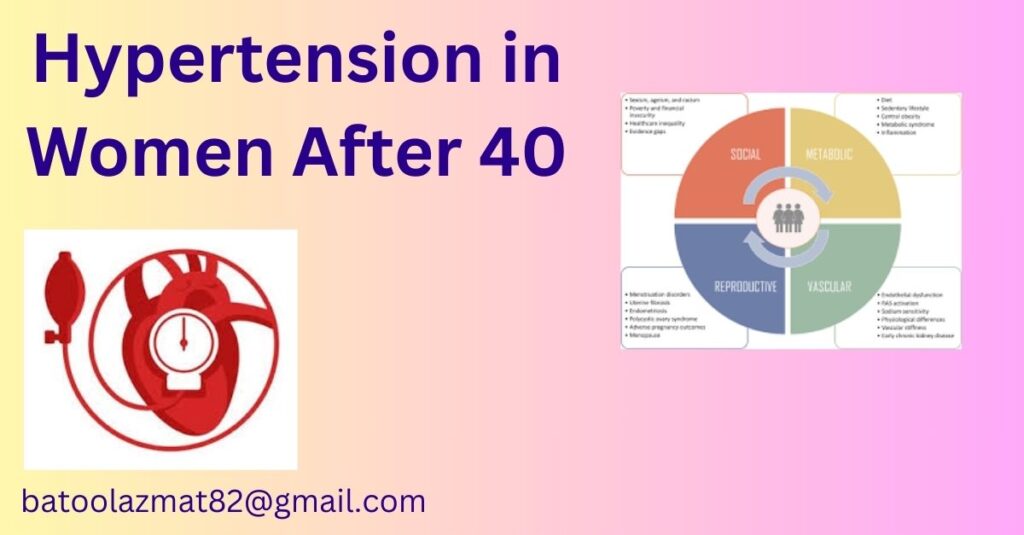Title: Hypertension in Women After 40: Causes, Risks, and How to Stay in Control
Introduction: The Silent Threat Facing Women Over 40
After 40, many women begin focusing more on their health — watching weight, managing hormones, and checking in on cholesterol.
Known as the “silent killer,” hypertension in women after 40 is more common than you might think. And while men tend to develop high blood pressure earlier, post-menopausal women are at higher risk for complications.
The good news? With awareness and the right lifestyle adjustments, you can take control and protect your heart. Let’s break down why this happens, what signs to watch for, and how to naturally manage your blood pressure after 40.

H2: What Is Hypertension?
- Heart disease
- Stroke
- Kidney problems
- Vision loss
Normal blood pressure: 120/80 mmHg
Hypertension starts at: 130/80 mmHg or higher
H2: Why Women Over 40 Are at Higher Risk
Several factors make hypertension in women after 40 more likely:
H3: 1. Hormonal Changes Hypertension in Women After

H3: 2. Weight Gain Hypertension in Women After
H3: 4. Salt Sensitivity
- Aging kidneys process salt less efficiently, leading to fluid retention and increased blood pressure.
H3: 5. Family History & Genetics
- If your parents or siblings have hypertension, your risk is significantly higher.
H2: Common Symptoms of Hypertension in Women Hypertension in Women After 40
- Persistent headaches
- Dizziness or lightheadedness
- Chest pain
- Shortness of breath
- Blurred vision
- Fatigue
- Irregular heartbeat
📝 Note: If you’re experiencing any of these symptoms, especially with a reading above 130/80 mmHg, consult a doctor immediately.
H2: How to Check and Monitor Blood Pressure at Home Hypertension in Women After 40
Monitoring your BP regularly is one of the best things you can do.
Steps for accurate home measurement: Hypertension in Women After 40
- Sit calmly for 5 minutes before measuring
- Take readings at the same time daily
- Keep a log to share with your doctor
Digital home monitors are widely available and easy to use.
H2: Natural Ways to Manage Hypertension in Women After 40
H3: 1. Adopt the DASH Diet
(Dietary Approaches to Stop Hypertension)
Key components:
- Low in sodium
- High in potassium, calcium, and magnesium
- Rich in vegetables, fruits, whole grains, lean proteins
H3: 2. Reduce Sodium Intake
- Limit to under 1500 mg/day
- Avoid processed foods, canned soups, chips, fast food
H3: 3. Increase Physical Activity
- Great options: brisk walking, swimming, cycling, yoga
H3: 4. Maintain a Healthy Weight
H3: 5. Limit Alcohol and Quit Smoking
- Smoking stiffens arteries and raises pressure
H3: 6. Manage Stress
- Daily deep breathing
- Journaling or talking to a therapist
- Guided meditations or calming music
H3: 7. Sleep Well
- Aim for 7-8 hours nightly
- Poor sleep increases cortisol, which raises BP
H2: Real-Life Inspiration: Controlling Hypertension Naturally
Case Study: Shazia, 47 – Reversing High Blood Pressure with Lifestyle Changes
Shazia was diagnosed with 145/95 BP at a routine check-up.
H2: When Medication Is Necessary
Lifestyle changes are essential, but sometimes medication is required. Your doctor may prescribe:
- Diuretics (to remove excess salt)
- ACE inhibitors
- Beta-blockers
- Calcium channel blockers
FAQ: Hypertension in Women After 40
2. Can menopause cause high blood pressure?
Menopause itself doesn’t cause hypertension, but hormonal changes can make arteries less flexible, increasing the risk.
3. How often should women over 40 check their blood pressure?
At least once every 6 months if you’re healthy, and more frequently if you’re at risk or already diagnosed.
4. What foods can lower blood pressure fast?
- Leafy greens (spinach, kale)
- Berries
- Bananas
- Oats
- Beets
- Garlic
5. Can stress alone cause high blood pressure?
Chronic stress contributes to hypertension but rarely causes it alone. It’s usually a combination of lifestyle, genetics, and aging.